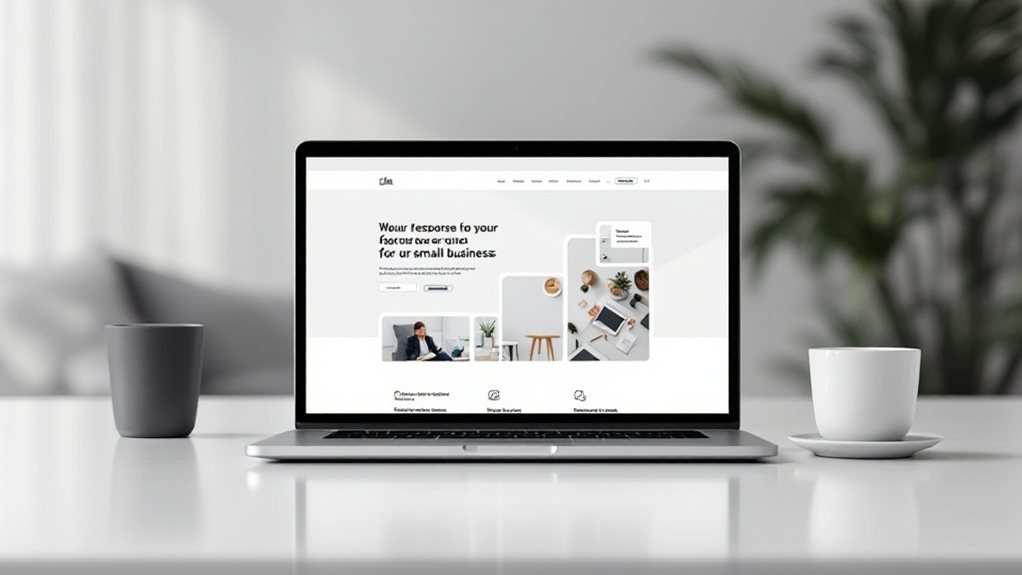As a small business, you need a website that looks great and functions seamlessly across all devices. Responsive web design services can provide a cost-effective solution, ensuring your online presence is optimized for both desktop and mobile users. You'll benefit from increased visibility, improved user experience, and higher conversion rates. To learn more about the key features and best practices of responsive design, keep reading.
Key Takeaways
- Responsive web design services create mobile-friendly, optimized websites that enhance small business online visibility and user engagement across devices.
- Expert responsive design services ensure a seamless and consistent user experience, boosting small business conversions and customer loyalty.
- Responsive design services provide a cost-effective solution for small businesses, eliminating the need for separate mobile and desktop websites.
- Comprehensive responsive web design services include fluid layouts, adaptive media, and performance optimization to deliver fast-loading, accessible websites.
- Ongoing monitoring and optimization of responsive design metrics empower small businesses to continually improve their online presence and reach more customers.
The Importance of Responsive Web Design

As more people access the internet from their smartphones and tablets, having a responsive web design has become essential for small businesses. A responsive website automatically adjusts its layout and content to provide an optimal viewing and navigation experience across various devices. This ensures your customers can easily access your products, services, and information, regardless of the device they're using. With a responsive design, you'll improve user engagement, reduce bounce rates, and enhance your online presence. Additionally, search engines like Google favor responsive websites, as they provide a better user experience. Investing in responsive web design services can give your small business a competitive edge and help you reach more customers effectively.
Benefits of Responsive Web Design for Small Businesses
Why opt for responsive web design services? As a small business owner, you can't afford to ignore the needs of mobile users. Responsive design ensures your website looks great and functions seamlessly across all devices. It boosts your online visibility, improves user experience, and enhances customer engagement. With a responsive site, you can reach more potential customers, increase conversions, and stay ahead of the competition. Moreover, it's cost-effective – you only need to maintain one website instead of separate mobile and desktop versions. Investing in responsive web design services is a smart move that will pay dividends for your small business in the long run.
Key Features of a Responsive Website

A responsive website comprises several key features that optimize its performance and user experience across various devices. Fluid layouts adapt to the screen size, ensuring content and elements scale seamlessly. Flexible images and media dynamically resize to fit the viewport. Strategic use of CSS media queries detects device characteristics and applies appropriate styles. Intuitive navigation, with a simple menu that's easy to access on any device, enhances usability. Fast load times, thanks to optimized code and assets, deliver a smooth browsing experience. Ultimately, these responsive design elements work in harmony to provide customers an engaging, device-agnostic digital presence that meets their needs, no matter how they access your site.
Responsive Design Principles and Best Practices
Designing a truly responsive website requires adherence to several key principles and best practices. First, ensure your website's layout and content adapt seamlessly across different screen sizes and devices. Implement a mobile-first approach, prioritizing the mobile user experience. Leverage flexible grids, fluid images, and media queries to create an adaptive design. Optimize your website's performance by minimizing file sizes and leveraging caching. Lastly, conduct thorough testing across various devices and browsers to identify and address any usability issues. Following these responsive design principles will help you create an exceptional user experience, regardless of how customers access your website.
Responsive Web Design Techniques and Strategies

How do you effectively implement responsive web design techniques and strategies? Start by adopting a mobile-first approach, designing for the smallest screen size first. Use fluid grids, flexible images, and media queries to create an adaptive layout that adjusts seamlessly across devices. Leverage responsive typography, ensuring your content remains legible and visually appealing on any screen. Optimize images, minimize HTTP requests, and leverage browser caching to enhance site performance. Prioritize content and functionality, eliminating unnecessary elements that may hinder the user experience. Test thoroughly across a range of devices and browsers, making refinements as needed. Embrace a continuous improvement mindset, regularly evaluating and updating your responsive design to keep pace with evolving technology and user expectations.
Choosing the Right Responsive Web Design Service
Choosing the right responsive web design service can be a crucial decision for small businesses looking to establish a strong online presence. It's essential to evaluate the service provider's expertise, portfolio, and communication skills. Consider their understanding of your industry and target audience to ensure they can deliver a website that resonates with your customers. Ensure the service offers comprehensive solutions, from design to development and ongoing maintenance. Evaluate their flexibility and responsiveness in addressing your unique needs. Compare pricing and turnaround times to find the best value. Ultimately, the right responsive web design service will enhance your brand's digital footprint and drive engagement with your target market.
Responsive Web Design for Optimal User Experience

A responsive web design that prioritizes the user experience is paramount for small businesses seeking to captivate their audience. By optimizing your website for seamless navigation across devices, you'll ensure customers can effortlessly access your content, products, and services. Responsive design adapts to the user's screen size, orientation, and device capabilities, delivering a cohesive and enjoyable experience. This not only enhances customer satisfaction but also boosts your online visibility and credibility. Investing in a responsive web design demonstrates your commitment to providing a top-notch digital experience, setting you apart from competitors and fostering long-term customer loyalty.
Integrating Responsive Design With Existing Websites
If you have an existing website that needs to be updated with responsive design, the process can be streamlined by leveraging your current codebase. By analyzing your website's structure and content, a skilled web development team can identify opportunities to incorporate responsive design elements without the need for a complete rebuild. This approach allows you to maintain brand consistency and minimize disruption to your online presence. Additionally, integrating responsive design with your existing website can improve its performance, accessibility, and overall user experience, making it more engaging and effective for your small business.
Responsive Web Design and Search Engine Optimization

While implementing responsive web design is crucial for providing an optimal user experience, it also has a significant impact on your website's search engine optimization (SEO). Responsive design ensures your site is easily accessible and navigable across devices, which Google and other search engines favor. Additionally, a responsive layout can improve page speed, another important SEO factor. By creating a cohesive and mobile-friendly website, you'll enhance your search visibility and attract more qualified leads. Ultimately, responsive web design and SEO work hand-in-hand, helping you reach your target audience and grow your small business online.
Measuring the Success of Responsive Web Design
Measuring the success of your responsive web design efforts is paramount. Tracking key metrics like mobile traffic, bounce rates, and conversion rates will reveal how effectively your site is meeting the needs of mobile users. Regularly reviewing analytics data can help you identify problem areas and make data-driven improvements. Seek feedback from customers, too – their insights on the user experience can be invaluable. Overall, continuously monitoring and optimizing your responsive design is crucial for ensuring it delivers the intended results for your small business. Stay agile, and don't be afraid to make changes based on the data you collect.
Maintenance and Updates for Responsive Websites

Keeping your responsive website up-to-date and well-maintained is essential for its long-term success. Regularly reviewing and updating your content, optimizing images and videos, and ensuring compatibility with the latest web standards and devices is crucial. Partnering with a web design agency can simplify this process, as they'll handle software updates, security patches, and performance enhancements. Investing in ongoing maintenance ensures your website remains visually appealing, functionally robust, and adaptable to evolving user needs. Don't let your responsive website become outdated; embrace a proactive approach to maintenance and updates to maximize its effectiveness and keep your small business thriving online.

